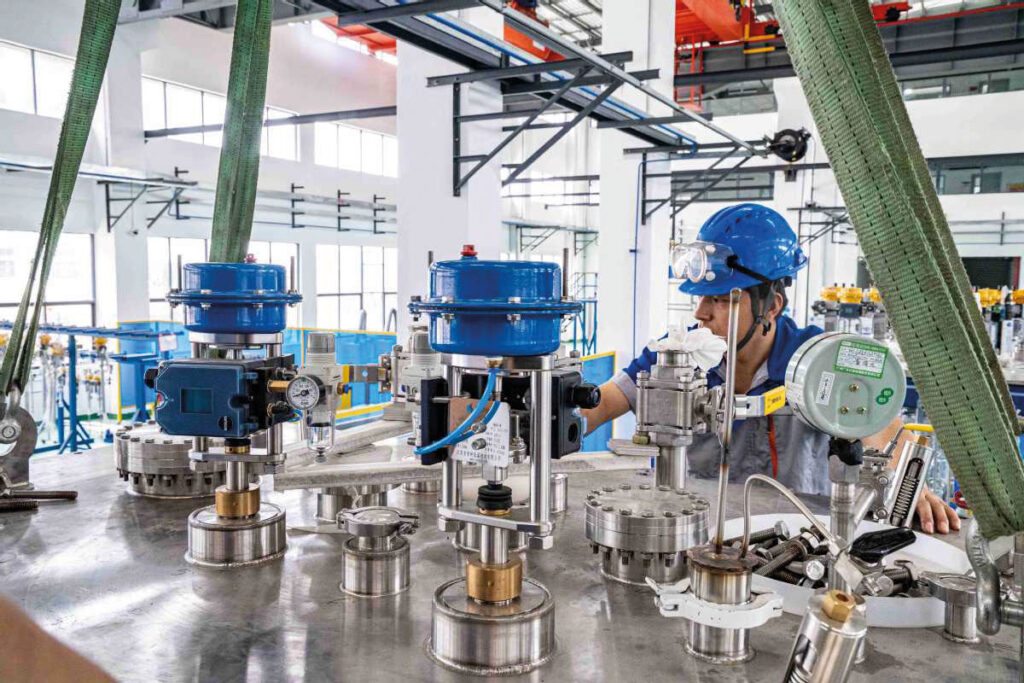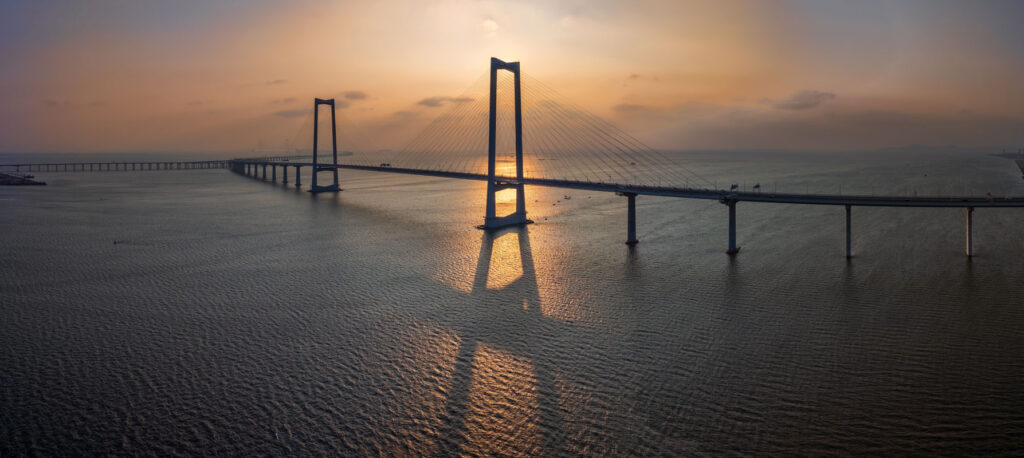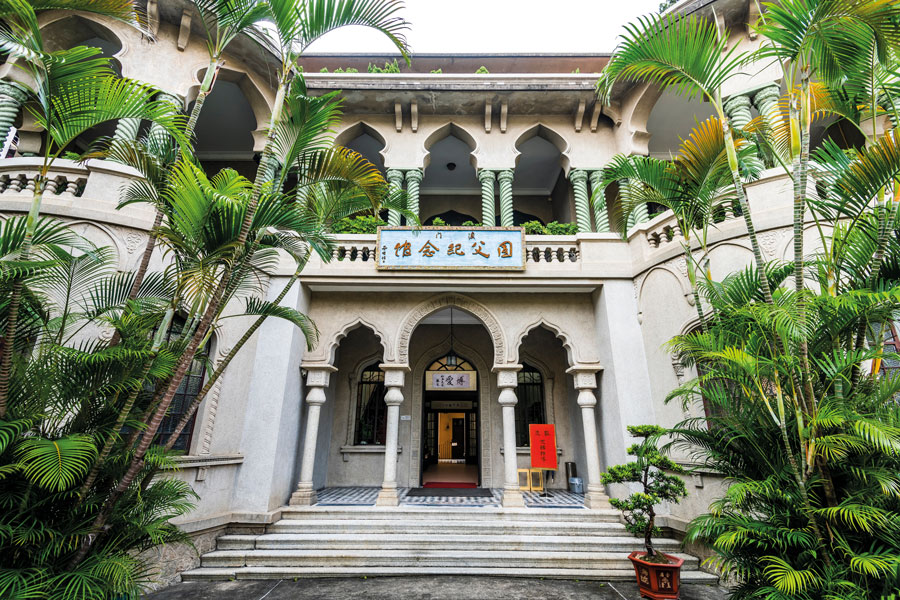Just 39 kilometres separate Macao from Zhongshan, a leafy river city in the heart of Guangdong Province. But these two hubs of the Guangdong-Hong Kong-Macao Greater Bay Area (GBA) share more than geographical proximity; their historical, cultural and economic connections run incredibly deep. Today, around a quarter of Macao’s current residents hail from the mainland city of 4.5 million people.
One of them is Chief Executive Sam Hou Fai, born in Zhongshan in 1962. Sam, who has dedicated himself to the Special Administrative Region (SAR) for the past 30-odd years, is proactively strengthening ties between the two cities. Zhongshan was part of his three-city tour of Guangdong Province in late April, when he and a delegation from Macao met with Secretary of the Zhongshan Municipal Committee of the Communist Party of China and Chairperson of the Zhongshan Municipal People’s Congress Standing Committee Guo Wenhai.
At that meeting, Sam highlighted Macao and Zhongshan’s complementary strengths in their respective health industries. In particular, he noted that traditional Chinese medicine (TCM) is a promising emerging sector in the SAR, while Zhongshan is a well-established hub for biopharmaceuticals. The chief executive raised the possibility of establishing a demonstration centre in Zhongshan for “Macao formulas, Guangdong production” to facilitate the integrated development of healthcare within the GBA.
Sam and Guo also met a month prior, at Government Headquarters in Macao. There, they discussed ways of strengthening cooperation between the two regions. Areas examined included the economy and trade, biomedicine, culture and tourism, advanced technology, and higher education. They reflected on Macao and Zhongshan’s already very positive relationship, and Sam shared his hope that enterprises from the latter would further leverage Macao as a platform for commercial cooperation between China and Portuguese-speaking countries (PSCs) – expanding the nation’s trade and investment relations around the world in the process.
A manufacturing powerhouse

Indeed, Zhongshan offers plenty of scope for commercial collaboration. Known as one of the ‘Four Little Tigers’ of Guangdong (alongside Dongguan, Nanhai and Shunde), the city boasts a vibrant economy led by several pillars of strategic manufacturing. Sectors include household appliances, lighting, hardware, electronics, mahogany and rosewood furniture, and textiles. Zhongshan has developed specialised industrial clusters in its various districts: Dachong is dubbed ‘China’s Cowboy Clothing Town’ for its denim output, for example, while Guzhen is renowned as the country’s ‘Lighting Capital’.
The three biggest companies headquartered in Zhongshan are motor-maker Broad-Ocean, whose products are widely used in household appliances, and two chemicals giants, Hawley & Hazel Chemical and Lanju. Hawley & Hazel is best-known for its toothpastes; Lanju for its mosquito repellents.
While the Chinese home appliance giants Midea and TCL are headquartered elsewhere, their production centres are in Zhongshan. These contribute significantly to the city’s robust export figures, which hit a record 249.14 billion yuan (US$34.13 billion) last year – a 12.6-percent increase from 2023. According to official statistics, home appliances exports saw year-on-year growth of 20.6 percent in 2024 and accounted for 26.2 percent of Zhongshan’s total exports.
Exports to emerging markets showed particularly significant increases, with double-digit growth to countries participating in the Belt and Road Initiative (which includes several PSCs), the Association of Southeast Asian Nations (ASEAN) and China’s fellow BRICS members. Notably, Zhongshan’s exports to Latin American markets surged by 32.4 percent last year, with Brazil – the world’s largest PSC – experiencing explosive growth of 67.1 percent (second only to Peru in the region).
Building bridges – literally

At Sam and Guo’s meeting in March, Macao’s leader highlighted recent improvements in transportation links within the GBA facilitating greater regional integration and intra-regional visitor flow. One milestone is the Shenzhen-Zhongshan Link, which marks the one-year anniversary of its inauguration this month. This 24-kilometre mega-crossing – featuring two bridges, two artificial islands, and an underwater tunnel – has slashed travel time between Zhongshan and Shenzhen from two hours to just 30 minutes.

Driving between Macao and Zhongshan, meanwhile, takes around 45 minutes. Since January, a new ferry service has added further convenience, operating two round trips daily between Macao’s Taipa Ferry Terminal and Zhongshan Passenger Port. The journey by sea takes around 50 minutes. These transport upgrades are part of the GBA’s broader vision to create a “one-hour living circle” through a comprehensive, interconnected transit network.
A tri-city tourism alliance
Also in March, the tourism offices of Macao, the SAR’s neighbouring Chinese mainland city of Zhuhai and Zhongshan held their annual summit (the three form a tourism alliance established in 2006). Discussions centred around joint branding strategies, expanding visitor markets through multi-destination travel packages and updates to their shared guide for foodies, A Handbook of Gastronomy in Zhongshan, Zhuhai and Macao.
The summit, chaired by Macao Government Tourism Office (MGTO) Director Maria Helena de Senna Fernandes, took place in Zhongshan. In attendance were Zhong Guohuai, director of the Zhuhai Tourism Development Centre, and Huang Jianmin, head of Zhongshan’s Culture, Radio, Television and Tourism Bureau.
While international visitor sources – particularly from Southeast Asia – were a key focus, domestic tourism was also examined. Infrastructure projects like the Hong Kong-Zhuhai-Macao Bridge and the Shenzhen-Zhongshan Link, coupled with looser entry-exit rules between the mainland and the SARs, have made cross-boundary travel easier for travellers. New multiple-entry permits for residents of Zhuhai, Hengqin and Shenzhen, as well as the northbound travel scheme for Macao and Hong Kong residents visiting the mainland, have further boosted inter-regional mobility since the start of this year.
Mainlanders, including many from Zhongshan, make up the vast bulk of Macao’s visitor numbers. They flock to the SAR to experience its vibrant dining scene, unique blend of Chinese and European culture, and world-class integrated resorts. Conversely, many Macao residents enjoy Zhongshan’s recreational offerings and some have even bought second homes there. Golf is one significant drawcard: the 36-hole Zhongshan Hot Spring Golf Club, with courses designed by US sporting legends Jack Nicklaus and Arnold Palmer, is a favourite among Macao visitors. Located in Sanxiang Town, it was the first golf club established in the Chinese mainland.
Different parts of Zhongshan also draw food lovers from near and far with local specialities. Shiqi district is famed for its namesake roasted pigeon and Huangpu for its traditional cured meats; Nanlang, meanwhile, is known for delicious crab dishes and Dongsheng is celebrated for its crispy grass carp. Xiaolan Town, nicknamed ‘Chrysanthemum City’, serves up fragrant desserts made with the flower that has come to define its local culture.

Many of Zhongshan’s most iconic attractions, however, relate to the city’s most famous resident: Dr Sun Yat-sen, known as a great pioneer of democratic revolution in modern China. Originally called Xiangshan, the city was renamed Zhongshan in 1925 to honour his legacy. Born in 1866, Sun is known as Sun Zhongshan, the Mandarin version of his name, in the mainland. Many of the great man’s admirers visit the Museum of Dr Sun Yat-sen in Cuiheng village (part of modern-day Zhongshan), where Sun spent his early years. The sprawling site includes his childhood home, a memorial hall, a folk house exhibition and a farming exhibition.
Another key site is the Sunwen Xi pedestrian street, which has been designated a national tourism and leisure block. This vibrant throughfare features many well-preserved historic buildings housing upscale boutiques. Sun Wen was another name the doctor-turned-revolutionary was known by.
Sharing Sun Yat-sen’s legacy

Sun is one of many human ties between Macao and Zhongshan: he resided in both cities at different times in his life. After attending secondary school in the Kingdom of Hawaii (now part of the US) and studying medicine in Guangzhou and Hong Kong, Sun moved to Macao to work as a physician at Kiang Wu Hospital in 1892. He was the first Chinese person in the city to practise Western medicine. While Sun’s time in Macao was short at just 16 months, his ties to the city were already strong and remained so. His father worked in a shoe shop here in the years preceding Sun’s birth, and Sun’s first wife, Lu Muzhen, later lived in Macao for decades with two of the couple’s three children. Their Moorish-style mansion near Guia Hill was converted into the Sun Yat-sen Memorial House in 1958. Today, the museum offers a fascinating window into the life of the revolutionary through artefacts and photography.
To mark the 100th anniversary of Sun’s death in 1925, the governments of Macao, Hong Kong and Guangdong have jointly organised an exhibition celebrating his life. Featuring over 100 historic items and photographs, it opened in March at the Museum of Dr Sun Yat-sen in Zhongshan. August will see the exhibition relocate to Macao, before heading to Hong Kong at the end of the year.
Enduring ties and future cooperation
Human connections past and present lay the groundwork for future cooperation between Macao and Zhongshan. Beyond Sun and Sam, tens of thousands of Zhongshan-born residents now call Macao home, while organisations like the Macao Zhongshan Minzhong Communal Friendship Association help maintain these links. Its current chairman, Lou Sai Hou, welcomed a delegation from the Zhongshan Municipal Committee of the Chinese People’s Political Consultative Congress (CPPCC) earlier this year.
“Since our association was set up, we have promoted the love of Macao and of the country, serving our fellow Zhongshan people and providing welfare to them,” he told local Chinese media at the time. “We’ve encouraged our members to be active and innovative and earn the recognition of all sectors of society.”
Zhuang Shujun, chairman of the CPPCC Zhongshan Municipal Committee, has described Zhongshan and Macao as close neighbours with an excellent foundation of cooperation and frequent contact. He noted that Zhongshan’s people were eagerly taking part in the construction of China’s flourishing southern megalopolis, the GBA, which included their contributions in Macao. Indeed, the relationship between the two cities serves as an important part of regional development, modernising and strengthening the country as a whole.



